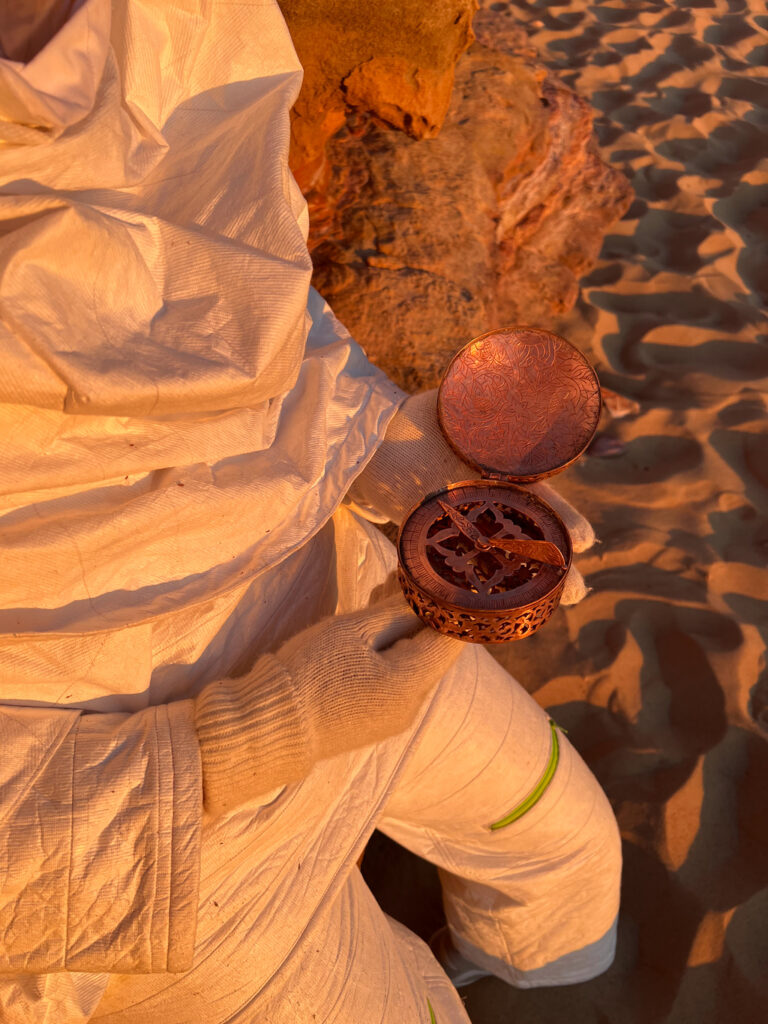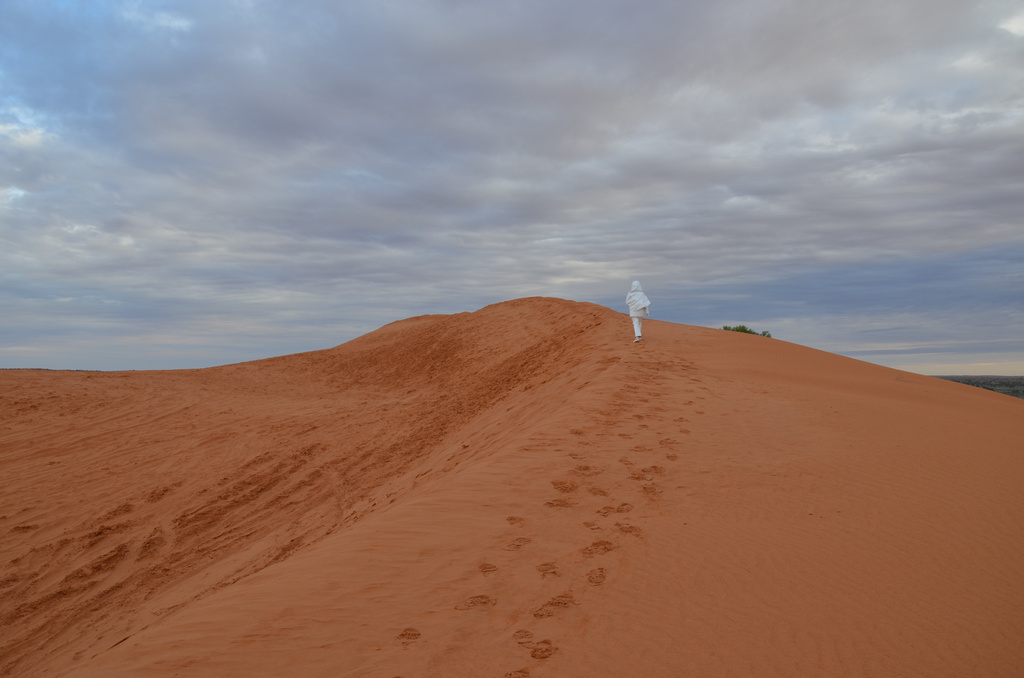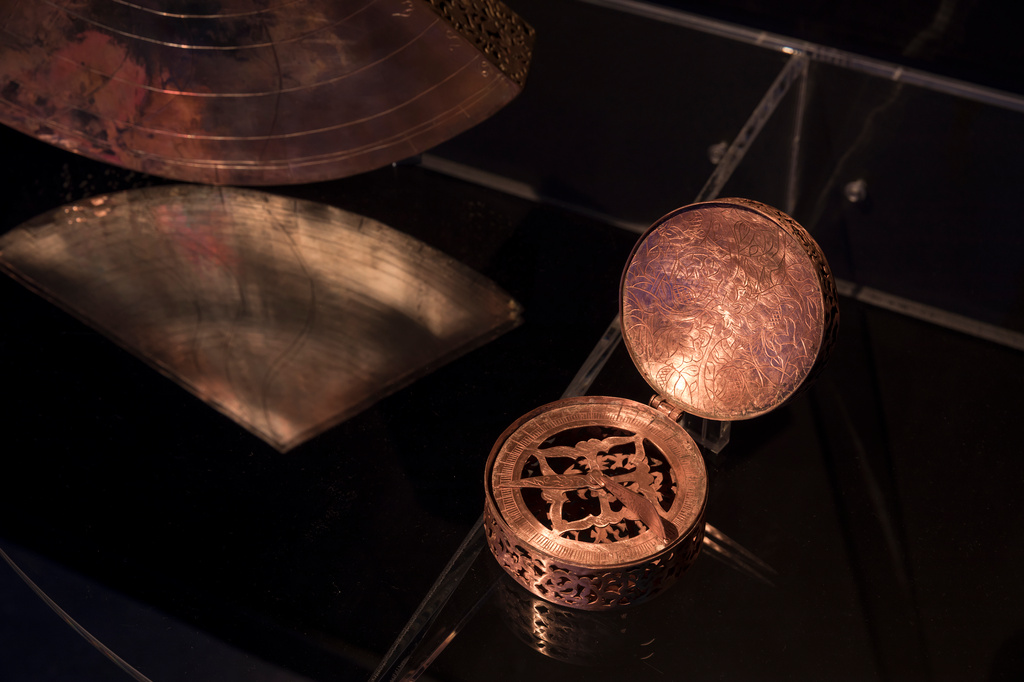
Qibla + compass, 2024, hand pierced, engraved copper, silver solder, Image taken by Andrew Curtis, image courtesy of TarraWarra Museum of Art
Shireen Taweel guides us across the stars to Karajarri country on the Indian Ocean.
Pilgrimage of the Hajjanaut documents a sacred experience undertaken by an Islamic Arab Woman of diaspora in Space. The speculative figure, a Hajj pilgrim, undertakes an imagining of the Hajj pilgrimage off earth, charting the dark sky by implementing Islamic heritage practices of astronomy and celestial navigation. A sacred architect of future-oriented ritual practices, politics, faith and science, the Hajjanaut challenges stereotypes and agency of the female body.
“It is he who has created for you the stars so that you can be guided by them in the darkness(es) of land and sea.”
Quran – Sura 6 verse 97
“Histories and imaginings, risings, trajectories and settings, navigate my spirit through space.”
Hajjanaut – Envoy of Humankind
Al-‘abur al-Yamaniyyah, “the passage of the South”, refers to the route taken by Suhail (Canopus) when fleeing for murder pursued by al-habor (Sirius). Suhail never sets below the horizon, having travelled so far south to avoid punishment. The passage of the south is the Hajjanauts’ route, 45 degrees south moving north; Suhail’s return. Suhail is key to locating the southern celestial pole and finding true north for the observational calculations of the pilgrimage
Mount John Observatory rests on the summit of Tītīkōpuke Ōtehīwai beneath the celestial dome of Aoraki Mackenzie Dark Sky Reserve. Al Nasr Al-Tair (The flying eagle) soars high in the northwestern sky, illuminating the direction of the Ka’aba, the brightest star in the spring triangle, slowly moves west
Beneath the stars mass twice that of the Earth’s sun
the Hajjanaut directs a quadrant towards the silver cadence of the night sky
calculating direction with the engraved and pierced latitude plate
charting the pilgrimage
the Hajjanaut and eagle negotiate
a constantly shifting relationship with the unfamiliar landscape
without cairns, visitations from the bird
gift bearings for the Tasman Sea
Prior to the pilgrimage, heritage practices of the MENA copper artisan were employed to engrave plates for the development of a set of celestial charts. The changes in location of the navigational stars of the southern hemisphere are recorded in pencil on the prints over the course of the pilgrimage. Before dawn and by late evening, the Hajjanaut has subtracted and added the degrees of latitude relational to where the navigational stars and planets are positioned. The visual understanding of celestial time, location and direction is a navigation of the movement of people, a pilgrimage and a speculative future: an inquiry into the ecology of the spirit for future cultural communion in space and place making.
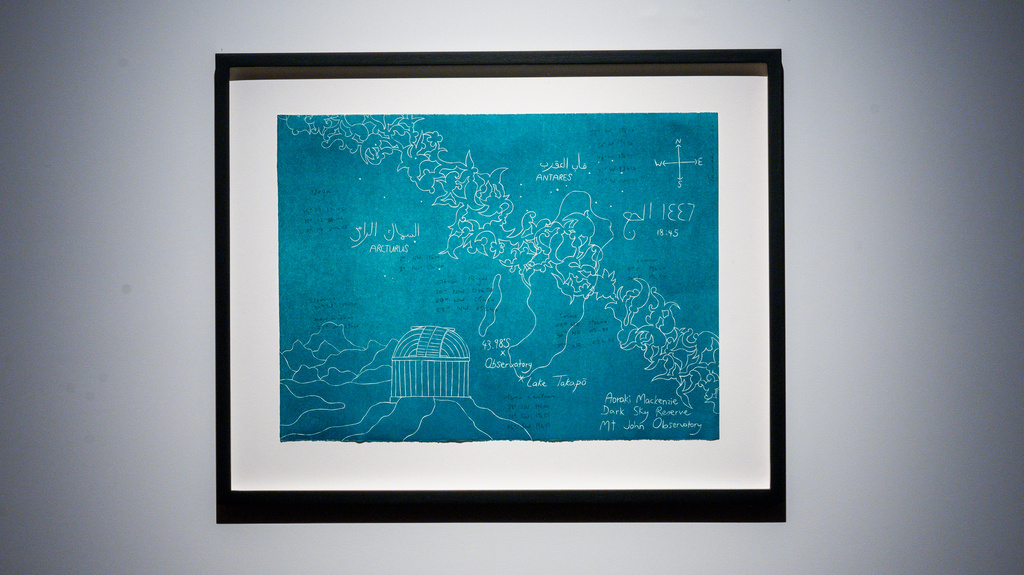
Lake Takapõ 43.98 degrees south, 2024, engraved copper plate, unique print, 39 x 53 cm, Image taken by Alex Lovell-Smith, image courtesy Dunedin Public Art Gallery, Aotearoa
Maghrib and Isha prayer times emersed in mountainsides of wild thyme
fragrant compendiums filling the body with memories and knowledge,
how does scent travel through space
fragility of sanctuary exposed and the mobility of the sacred challenged
separation from environment, the inability to experience the natural world intimately through all of the senses
migrating communities within extraterrestrial landscapes, developing a reverence for environment
Passing through a juncture in time, the dawn mist settles on the stone archives of the deceased.
within the soft light filtering through histories, the Hajjanaut finds the location
a corrugated tin mosque by the rear boundary of the burial place
kneeling on the crackling surface beneath two trees, she zips up the suit’s external flaps
metamorphosis of the sacred, a space Ihram converted into celestial architecture evoking the divine
in the moist air the Fajr dawn prayer returns to the surrounds of the rusting vernacular humpy
The suit is a design that fuses the Ihram worn on a Hajj pilgrimage with a current space suit. Science and tradition meet within the spectrum of belief, culture and religion. It is a subversion of the universal heritage and image of the astronaut as an envoy of humankind: a speculation and transition in space and time through movement, migration and the ecology of the ritual. This suit is a sacred reimagining of the context of the astronaut and the positionality of gender, embodied space, and space travel. Futurism is not a speculation of possible participation; it is a vision of making a future
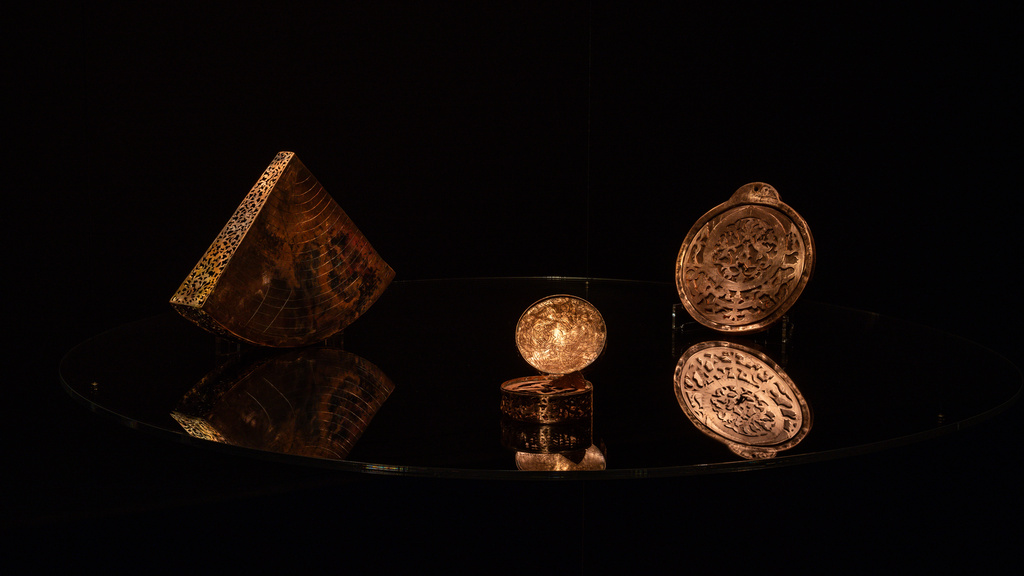
L – R: Southern celestial quadrant, 2024 hand pierced, engraved copper, silver solder. Qibla + compass, 2024, hand pierced, engraved copper, silver solder. Southern celestial astrolabe, 2024, hand pierced, engraved copper, silver solder; image taken by Alex Lovell-Smith, image courtesy Dunedin Public Art Gallery, Aotearoa
The Qibla + compass drops from her hand
into the fine sand of the red dune
the Hajjanaut observes time and her shallow boot prints in the sacred sand dune Nappanerica of Munga-Thirri the Simpson Desert is carved up by the violent traction of two rovers
a collision of sand, the sacred and dune bogans ensue
red granules wrenched from the soft form
an aggressive contest furrows the silken surface
Travelling on country from Gadigal to Karajarri, during the winter months, al-habor was low on the western horizon. In the nautical twilight, I was able to navigate northwest with the guidance of the star. By sunrise, al-habor had returned to the east for the early morning. Al-habor was an important guide with which to chart my journey to Karajarri country on the Indian Ocean
Ritual ecology: a ritual that fosters reciprocal relationships between the living and non-living, leading to the creation of sacred space
Jamrat: Stoning of the devil ritual
an echo a past
collectively performed across oceans
afternoon spent gathering rocks
the surface of a planet set ablaze with orange pigment
cragged landscape circling the evocation of the raising of three pillars
early morning hands
deftly placed actions
symbols of defiance and resistance to temptation
assembled pillars.
The Hajjanaut is the nightcomer
a star penetrating night
dismantling years
through her piling of rock
Ritual vanishes into the landscape
no traces left behind of the happening
no locations designated, recorded, or mapped
a relationship with celestial environment
changeable, impermanence
a future planet surface
a decolonising action
Closing the ritual, the Hajjanaut returns each rock to its original location, having stoned the devil
In the dusty Victoria River Roadhouse, Judbarra, the Hajjanaut listens to the whirr of blades and bursts of anticipation for weather reports. She recognises Uncle Bill Yidumduma Harney standing by a rack of faded postcards, waiting for a black tea with extra sugar. After a brief moment sharing knowledges of astronomy and Uncle Bill’s experience on the set of Warwick Thornton’s film, We Don’t Need a Map (2017), the Hajjanaut withdraws from the roadhouse and continues northwest into the hot afternoon light
- Shireen Taweel Pilgrimage of a Hajjonaut 2024-25 (production still) three-channel video Courtesy of the artist and STATION, Australia Image: Spencer Reid The artist acknowledges this work was filmed on the lands of the Karajarri People. Australia is a land of the Aboriginal and Torres Strait Islander People. Sovereignty was never ceded
- Shireen Taweel Pilgrimage of a Hajjonaut 2024-25 (production still) three-channel video Courtesy of the artist and STATION, Australia Image: Spencer Reid The artist acknowledges this work was filmed on the lands of the Karajarri People. Australia is a land of the Aboriginal and Torres Strait Islander People. Sovereignty was never ceded
- Shireen Taweel, Pilgrimage of a Hajjonaut 2024-25 (production still) three-channel video Courtesy of the artist and STATION, Australia Image: Spencer Reid The artist acknowledges this work was filmed on the lands of the Wangkangurru and Yarluyandi peoples. Australia is a land of the Aboriginal and Torres Strait Islander People. Sovereignty was never ceded
Nahr; the river or sacrifice
the dry bed hums with a low frequency
the Hajjanauts body fills with a guttural drone while her two gloved hands sift the sand
a high frequency stabs at the interior of her space suit
arriving seconds after each wave of the low note, the penetrating sharpness fading momentarily
the feelings of immersion in water continue
the drone from her closed mouth
high frequency arriving seconds after the low, sustained for longer
the helmet and suit buried in the dry creek bed
I arrived at Warrum Art Centre on Giga Country unsure whether I would be able to meet with artist Mabel Juli. I introduced myself to the art centre’s manager, sharing with her the distance I had travelled on pilgrimage and the navigation sculptures and celestial charts that had aided my journey. She then walked over to the artist studios where Mabel works and returned moments later, content that Mabel would like to meet.
There she is painting her Ngarranggarni (Dreaming), Garnkiny, the crescent moon. She warmly greets me with a generous embrace. After a cup of tea together, we chatted about her birth country, Darrajayin, the morning star (Venus) and my journey north west to the Indian Ocean, which she connected to her stories of the Cameleers.
Circumambulation of the Ka’aba
reaching the Indian Ocean on Karajarri Country
the destination
weeks of calculations oriented towards the Ka’aba
the centre of the universe
nautical skills
Indian Ocean
rich history of trade and cultural exchange for Muslims and First Nation people
beyond the shores
sailing to Arabia
Mecca
an off-Earth Mecca
celestial migration,
the first female Caliph
The Hajjanaut traces outlines in the sand
the universe with a stick
golden streaks of sand melding into the deep blue line of the horizon
her eyes lead along a bewitching geometry to the unseen
sunset ignites a detailed impression of the Ka’aba
rendered in the sand
replicated to scale
a shimmering black form is manifested in its magnitude
the Hajjanaut begins walking the first of seven circles around its exterior
- Pilgrimage of a Hajjanaut, 2024 – 2025, three channel film installation + directional sound; 19:30 minutes, premiered at We Are Eagles , TarraWarra Biennial of Art 2025
- Pilgrimage of a Hajjanaut, 2024 – 2025, three channel film installation + directional sound; 19:30 minutes, premiered at We Are Eagles , TarraWarra Biennial of Art 2025
About Shireen Taweel
 Shireen Taweel is a Sydney based multidisciplinary artist working on Gadigal Land. Taweel’s practice draws on speculative futurisms and alternative histories as a means to decolonise future cultural, political, and ethical dimensions of Space migration. Taweel focuses on the construction of future transcendental architecture and movement ecology informed by the Arabic sciences contribution of astronomy and celestial navigation instruments to the past and future of migration and pilgrimage. Taweel’s development and research is often site-specific working in collaboration with local communities, architecture and environment experimenting with the materiality of site. Conceptual applications of artisan techniques and speculative narrative drives cross-cultural discourse and dialogues of shared histories and fluid community identities. Visit shireentaweel.com and follow @shireen_taweel.
Shireen Taweel is a Sydney based multidisciplinary artist working on Gadigal Land. Taweel’s practice draws on speculative futurisms and alternative histories as a means to decolonise future cultural, political, and ethical dimensions of Space migration. Taweel focuses on the construction of future transcendental architecture and movement ecology informed by the Arabic sciences contribution of astronomy and celestial navigation instruments to the past and future of migration and pilgrimage. Taweel’s development and research is often site-specific working in collaboration with local communities, architecture and environment experimenting with the materiality of site. Conceptual applications of artisan techniques and speculative narrative drives cross-cultural discourse and dialogues of shared histories and fluid community identities. Visit shireentaweel.com and follow @shireen_taweel.


